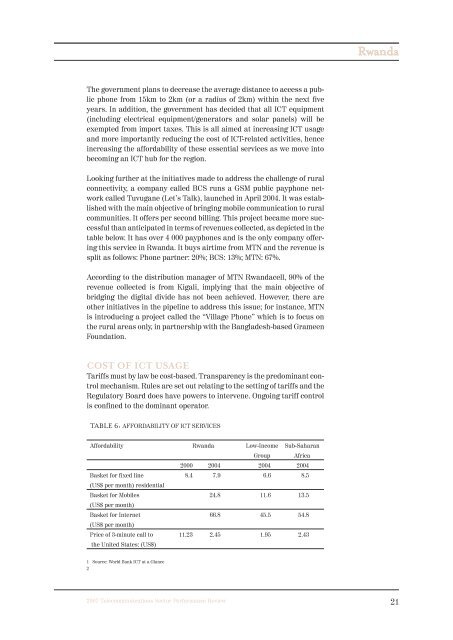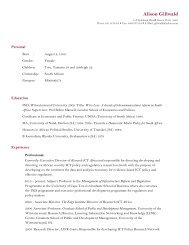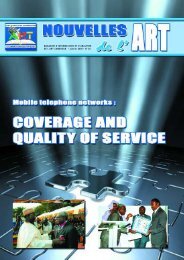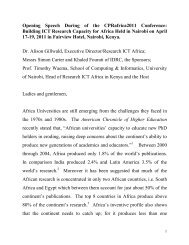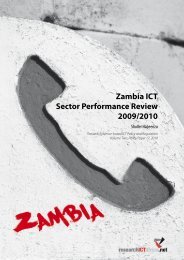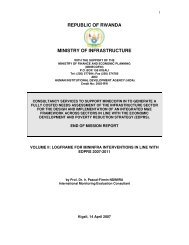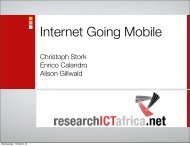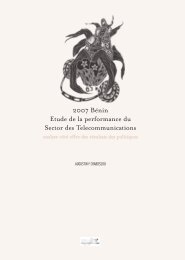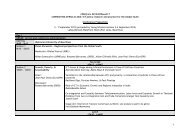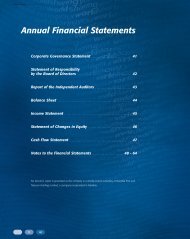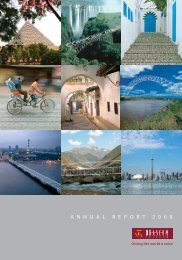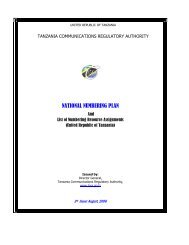Rwanda Telecommunications Sector Performance Review 2007
Rwanda Telecommunications Sector Performance Review 2007
Rwanda Telecommunications Sector Performance Review 2007
Create successful ePaper yourself
Turn your PDF publications into a flip-book with our unique Google optimized e-Paper software.
<strong>Rwanda</strong><br />
The government plans to decrease the average distance to access a public<br />
phone from 15km to 2km (or a radius of 2km) within the next five<br />
years. In addition, the government has decided that all ICT equipment<br />
(including electrical equipment/generators and solar panels) will be<br />
exempted from import taxes. This is all aimed at increasing ICT usage<br />
and more importantly reducing the cost of ICT-related activities, hence<br />
increasing the affordability of these essential services as we move into<br />
becoming an ICT hub for the region.<br />
Looking further at the initiatives made to address the challenge of rural<br />
connectivity, a company called BCS runs a GSM public payphone network<br />
called Tuvugane (Let’s Talk), launched in April 2004. It was established<br />
with the main objective of bringing mobile communication to rural<br />
communities. It offers per second billing. This project became more successful<br />
than anticipated in terms of revenues collected, as depicted in the<br />
table below. It has over 4 000 payphones and is the only company offering<br />
this service in <strong>Rwanda</strong>. It buys airtime from MTN and the revenue is<br />
split as follows: Phone partner: 20%; BCS: 13%; MTN: 67%.<br />
According to the distribution manager of MTN <strong>Rwanda</strong>cell, 90% of the<br />
revenue collected is from Kigali, implying that the main objective of<br />
bridging the digital divide has not been achieved. However, there are<br />
other initiatives in the pipeline to address this issue; for instance, MTN<br />
is introducing a project called the “Village Phone” which is to focus on<br />
the rural areas only, in partnership with the Bangladesh-based Grameen<br />
Foundation.<br />
COST OF ICT USAGE<br />
Tariffs must by law be cost-based. Transparency is the predominant control<br />
mechanism. Rules are set out relating to the setting of tariffs and the<br />
Regulatory Board does have powers to intervene. Ongoing tariff control<br />
is confined to the dominant operator.<br />
TABLE 6: AFFORDABILITY OF ICT SERVICES<br />
Affordability <strong>Rwanda</strong> Low-Income Sub-Saharan<br />
Group Africa<br />
2000 2004 2004 2004<br />
Basket for fixed line 8.4 7.9 6.6 8.5<br />
(US$ per month) residential<br />
Basket for Mobiles 24.8 11.6 13.5<br />
(US$ per month)<br />
Basket for Internet 66.8 45.5 54.8<br />
(US$ per month)<br />
Price of 3-minute call to 11.23 2.45 1.95 2.43<br />
the United States: (US$)<br />
1 Source: World Bank ICT at a Glance<br />
2<br />
<strong>2007</strong> <strong>Telecommunications</strong> <strong>Sector</strong> <strong>Performance</strong> <strong>Review</strong><br />
21


